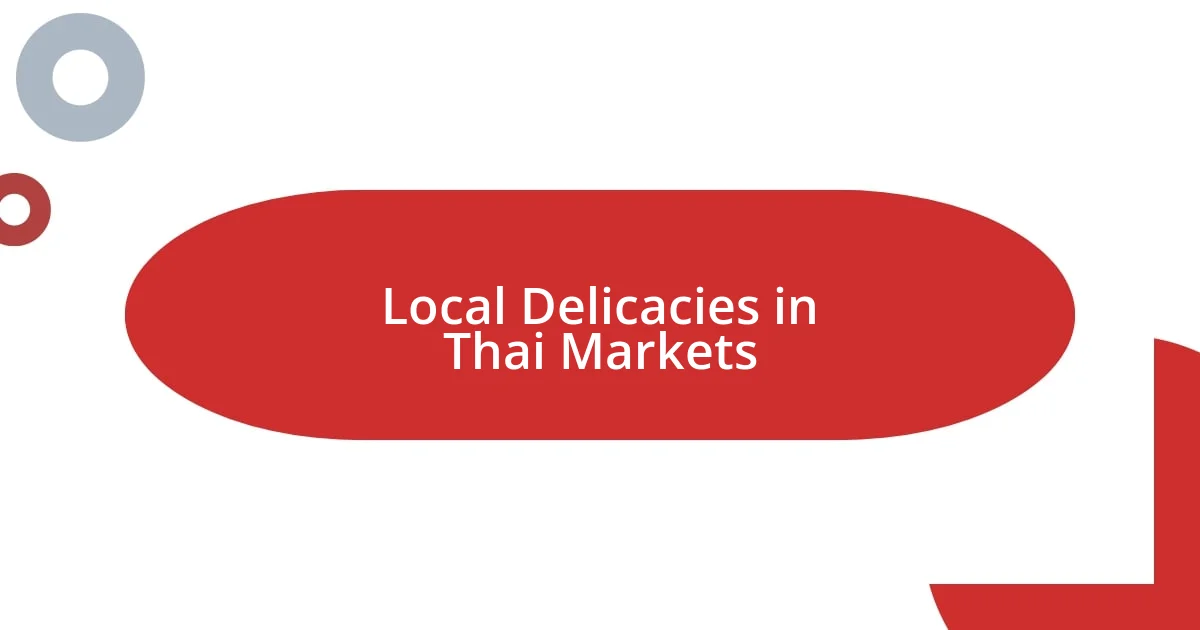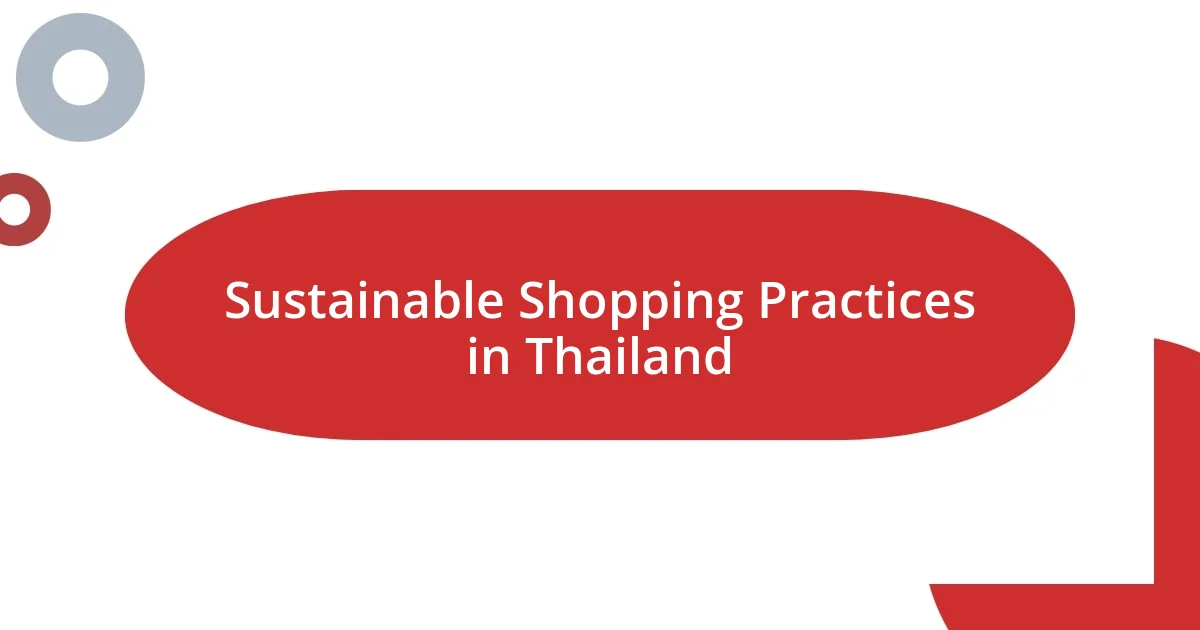Key takeaways:
- Thai markets provide a rich sensory experience, showcasing vibrant culture, local traditions, and the heartfelt connections made with vendors and their stories.
- Visitors can enjoy unique local delicacies that reflect the region’s culinary heritage, with iconic dishes like Pad Thai and mango sticky rice creating unforgettable flavors.
- Sustainable shopping practices are emphasized, with a focus on supporting local artisans, organic produce, and eco-friendly products that preserve cultural heritage and promote environmental awareness.

Exploring Thai Markets Benefits
One of the most compelling benefits of exploring Thai markets is the sensory experience they offer. I remember the first time I walked through a bustling market in Thailand—the vibrant colors of fresh produce, the enticing aroma of street food, and the lively chatter of vendors created an atmosphere that was almost intoxicating. Isn’t it delightful when a place can awaken all your senses at once?
Beyond the lively sights and sounds, Thai markets are treasure troves of cultural insights. When I interacted with local vendors over the years, sharing smiles and stories, I felt a genuine connection to their way of life. It’s as if every stall tells a story about tradition, community, and the years of craftsmanship behind their products. How refreshing it is to learn about the culture through food, art, and local goods rather than through travel brochures!
Moreover, shopping at Thai markets supports the local economy in a significant way. I’ve always preferred buying directly from artisans whose faces I recognize, knowing my purchases help sustain their livelihoods. Have you ever felt the warmth of making a purchase that feels both ethical and meaningful? That sense of connection adds an entirely new dimension to the experience.

Local Delicacies in Thai Markets
Visiting Thai markets offers a unique culinary adventure that you simply can’t replicate elsewhere. When I stumbled upon a small stall filled with freshly prepared mango sticky rice, I couldn’t resist. The vendor, with a twinkle in his eye, explained how the glutinous rice was carefully picked and steamed to perfection, served alongside sweet coconut milk and ripe mango slices. That moment showed me how each dish is a labor of love, creating flavors that linger long after the last bite.
Here are some local delicacies you might discover:
- Som Tam (Papaya Salad): A zesty mix of shredded green papaya, chili, lime, and fish sauce that delivers a delightful crunch.
- Pad Thai: Stir-fried noodles embellished with shrimp, tofu, peanuts, and bean sprouts—a true classic.
- Khao Niew Mamuang (Mango Sticky Rice): A sweet dessert combining sticky rice, fresh mango slices, and coconut milk.
- Khanom Jeen (Rice Noodles): Soft rice noodles served with spicy curry; every vendor has its secret recipe.
- Satay Skewers: Grilled meat on sticks, usually served with a savory peanut sauce—a must-try street treat.
Each bite tells a story, connecting me to the local culture and flavor, forming an unforgettable part of my Thailand experience.

Shopping for Unique Souvenirs
Shopping for unique souvenirs in Thai markets is an experience that brings such joy. I remember my visit to Chatuchak Market, where I spotted a hand-painted ceramic bowl that caught my eye. Its intricate design spoke to me, and the vendor joyfully shared the story behind the artistry. I was surprised to learn that each piece is created using traditional methods passed down through generations. There’s something truly special about owning a piece of culture, don’t you think?
Now, when it comes to unique souvenirs, the variety can be overwhelming—especially when comparing handcrafted items to mass-produced trinkets. I often find it more meaningful to choose locally-made products. Scrolling through my collection of souvenirs, I cherish the wooden elephant I bought from a small family-run stall; it reminds me of my connection with the vendor and the heart he put into every carve. Don’t you just love it when a souvenir can spark a cherished memory?
In looking for special items, consider local arts and crafts. I came across colorful textiles that tell the story of the region’s heritage. The detail in the weaving captivated me, and hearing the artisans speak about their work made it even more compelling. It really reinforced my belief that shopping for souvenirs shouldn’t just be about the item itself but the experience and stories that come with them.
| Souvenir Type | Description |
|---|---|
| Handcrafted Items | Unique, intricate designs that often tell a cultural story. |
| Textiles | Vibrant fabrics such as scarves or bags that showcase local craftsmanship. |
| Ceramics | Beautifully painted pottery that reflects traditional Thai artistry. |

Bargaining Tips for Thai Markets
Bargaining in Thai markets is more art than science, and it’s an experience that I always relish. I remember haggling for a beautiful woven bag—I started with an offer that made the vendor chuckle, and surprisingly, it sparked a cheerful banter between us. Remember that the key is to keep a friendly demeanor; a smile can go a long way in building rapport, making the experience more enjoyable.
Another tip I’ve found helpful is to know the market price before you negotiate. I often do a quick scan of stalls selling similar items so I have a solid baseline. That time I almost bought a pair of hand-crafted sandals without looking around ended up being a lesson learned—my persistence uncovered a better style for a fraction of the price just a few stalls down! Isn’t it satisfying to walk away knowing you’ve snagged a good deal?
Lastly, be prepared to walk away if the price doesn’t feel right. This tactic helped me when I was eyeing a gorgeous silk scarf. The vendor was reluctant to lower her asking price, but after a few moments of hesitation, I turned to leave. To my surprise, she called me back with a price that felt just right. Have you ever experienced that delightful moment of negotiation success? It reinforces the fact that sometimes patience truly pays off!

Cultural Experiences in Market Visits
Exploring Thai markets is like stepping into a vibrant tapestry of culture. I vividly recall wandering through the night market in Chiang Mai, where the scent of grilled skewers filled the air. It was mesmerizing to see local families gathering around food stalls, sharing laughter and stories. Isn’t it fascinating how food can bring people together? In that moment, I felt a deeper connection to the community, surrounded by the warmth of shared experiences.
The artistry on display is truly a feast for the senses. At one stall, I marveled at the delicate intricacy of handmade jewelry. As I chatted with the artisan, who expertly crafted each piece, I could feel the pride in her voice. She explained the significance of the materials she used, which connected me even further to the culture. I often find that these personal stories transform my purchases into cherished memories. How many times have you bought something that simply felt like a token, only to discover its rich background later on?
Participating in local traditions can also enhance the cultural experience during market visits. At a festival market, I joined in a craft-making workshop, creating a traditional paper lantern. As I carefully folded the paper, the instructor shared tales of how this craft symbolizes new beginnings. I couldn’t help but feel a rush of inspiration. This hands-on experience made the act of buying souvenirs so much more meaningful. Have you ever felt that thrill when you’re not just a spectator but an active participant in a culture? It’s moments like these that linger in my heart long after leaving the market.

Navigating Popular Thai Markets
Navigating popular Thai markets can feel like diving into an exhilarating adventure. I remember my first visit to the Chatuchak Weekend Market in Bangkok; its sheer size was overwhelming! I decided to approach it systematically, first marking key areas on my map to navigate through the maze of stalls. Have you ever felt that rush of excitement while exploring something so vast? It’s a mix of curiosity and the fear of missing out on hidden gems.
As I meandered through the vibrant lanes, I discovered that each section of the market offers distinct treasures. One moment, I found myself in a cluster of antique shops, marveling at vintage trinkets. The stories behind each item whispered to me, creating a sense of nostalgia. The next moment, I was engulfed by the lively atmosphere of food stalls serving everything from spicy papaya salad to tantalizing mango sticky rice. Have you tasted a dish so delicious that it lingers in your memory long after? I still can’t forget that first bite of fragrant rice paired with fresh mango; it was simply blissful!
Another strategy I employed was to engage with the vendors. I recall chatting with a friendly seller of handmade crafts who shared her inspiration behind each piece. This conversation turned my simple purchase into a meaningful connection, making me feel like I was taking a piece of her story home with me. Isn’t it amazing how a personal interaction can elevate a transaction into something special? These experiences encourage me to remember that markets aren’t just for shopping; they’re about connecting with people, cultures, and stories.

Sustainable Shopping Practices in Thailand
Sustainable shopping practices in Thailand have become an integral part of the market experience. On one occasion, while exploring a local market in Phuket, I stumbled upon stalls dedicated to upcycled products. A vendor was showcasing bags made from recycled rice sacks, and I couldn’t resist picking one up. As I listened to her explain the process of transforming waste into art, I felt a sense of pride knowing my purchase was contributing to a more eco-friendly future. Have you ever felt that rush of empowerment when your choices align with your values?
I also admire how many Thai markets prioritize organic produce. During a visit to a small village market, I encountered farmers proudly displaying vibrant fruits and vegetables, all grown without chemical pesticides. It was fascinating to learn about their farming techniques, which honored both tradition and sustainability. I remember picking a few tomatoes and feeling the difference in their texture compared to supermarket varieties. Have you ever tasted something so fresh that it changed your perspective on food? It reinforces my belief that every bite we take can reflect our commitment to healthier choices for ourselves and the planet.
Another noteworthy practice I observed relates to the use of traditional fabrics in clothing stalls. It was heartwarming to see artisans preserving centuries-old techniques to create beautiful garments. One vendor I met, a woman who wove her own fabrics, shared how each piece not only tells a story but also supports local craftsmanship. I often think about how our purchasing decisions can help sustain these age-old practices. Isn’t it inspiring to consider that what we wear can have such a profound impact on cultural heritage? This connection makes my shopping experience in Thailand not just a transaction, but a meaningful contribution to sustaining the environment and culture.















